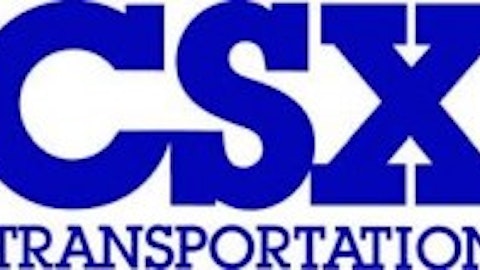The country’s major railroad companies recently came out with their 4th quarter and 2012 full year earnings. The amount of exposure to the weak coal markets helped discern the winners and losers among the rail companies. Low supplies of corn negatively affected agricultural revenue throughout the industry. Housing helped drive industrial product revenues, and oil demand continues to drive chemical freight. Overall, the western railroads won out in 2012:
| Consolidated 2012 figures | ||||
| Norfolk Southern Corp. (NYSE:NSC) (East) | CSX Corporation (NYSE:CSX) (East) | Kansas City Southern (NYSE:KSU) (Midwest) | Union Pacific Corporation (NYSE:UNP) (West) | |
| Yearly revenue growth | (1%) | 0.1% | 7% | 7% |
| Yearly operating income growth | (3%) | 1% | 17% | 18% |
| Operating ratio | 72% | 71% | 68% | 68% |
| Yearly net income growth | (9%) | 2% | 15% | 20% |
| Yearly operating cash flow growth | (5%) | (16%) | 6% | 5% |
| Yearly free cash flow growth | (12%) | (45%) | (3%) | (8%) |
| P/E ratio | 13 | 12 | 28 | 16 |
| Dividend growth | 28% | 20% | 100% | 29% |
| Dividend to free cash flow payout | 61% | 71% | 58% | 45% |
Source: Compiled from SEC documents
Consolidated look
In the table above, Union Pacific and Kansas City Southern increased their revenue the most and possess the highest levels of efficiency. Kansas City Southern and Union Pacific lead the way on operating cash flow growth increasing 6% and 5% respectively. Union Pacific and Kansas City Southern also paid out the least amount of free cash flow in dividends further highlighting cash prudence.
Segmented look
1.) Coal – Weaknesses in the coal market put a dent in the revenue of every railroad discussed here. In the table above, the biggest 2012 losers, Norfolk Southern and CSX, experienced a 1% decline and a 0.1% increase respectively in revenue. The coal segment as a percentage of total revenue for Norfolk Southern and CSX clocks in at 26% and 27% respectively.
At the same time, the biggest winners garnered the least amount of revenue from coal. Kansas City Southern and Union Pacific increased 2012 overall revenue 7% (consolidated table above). Percentages of 2012 revenue from coal for Union Pacific and Kansas City Southern came in at 20% and 11% respectively.
| Coal segment revenue change for 2012 | ||||
| Norfolk Southern (East) | CSX (East) | Kansas City Southern (Midwest) | Union Pacific (West) | |
| Coal | (17%) | (14%) | (13%) | (4%) |
Source: Compiled from SEC documents
Union Pacific’s coal revenues declined 4% representing the lowest decrease of the four railroad companies discussed (see table above). The increase in western coal freight revenue served as a buffer to its decline.
Natural gas prices remain low which means electric utilities will continue to give preference to it over coal, specifically central Appalachian coal. Even if natural gas prices rise, utilities may operate under a contract to utilize natural gas for some time, so the lag may last a while before the switch back to coal can happen. In essence, the coal segment will remain under pressure for some time.
US Natural Gas Wellhead Price data by YCharts
2.) Agriculture – Low corn supplies stemming from last year’s drought provided a boon to the American farmer and fertilizer companies such as Potash Corp./Saskatchewan (NYSE:POT) and Intrepid Potash, Inc. (NYSE:IPI); however, it hurt agricultural railroad freight with fewer crops to haul.
The railroad companies operating in the predominantly agricultural midwest and western states experienced the largest loss in agricultural revenue. Kansas City Southern, which operates predominantly in the Midwest, experienced a 3% drop in agricultural freight revenue. Union Pacific, a mostly western railroader, experienced a 1% decrease in the segment.
| Agricultural segment revenue change for 2012 | ||||
| Norfolk Southern (East) | CSX (East) | Kansas City Southern (Midwest) | Union Pacific (West) | |
| Agricultural | 0.5%* | (0.5%) | (3%) | (1%) |
*Includes agriculture/consumer/government
Source: Compiled from SEC Documents
Members of the farming community anticipate a number of new growers next season. In the absence of drought conditions a higher supply of corn and other crops will boost this segment.





